Cloud Computing Business Proposal: CRV P/L Startup Solution
VerifiedAdded on 2023/03/30
|7
|1020
|157
Report
AI Summary
This report provides a business proposal for CRV P/L, a new online marketing company, outlining the best cloud computing solution to handle their estimated 50,000 purchasing requests for their new sporting goods operation. It considers on-premise legacy implementation, on-premise private cloud, hybrid cloud, and public cloud options, and assesses whether the solutions can be supported by the company, a managed service provider, or the cloud provider. The proposal includes a risk assessment detailing potential risks to the company, a total cost of ownership (TCO) analysis, staffing implications, and final recommendations for selecting and implementing a viable cloud computing architecture that balances private and public cloud resources. The report emphasizes the importance of security, data privacy, and control, and the need for adjusting staffing to address security challenges associated with hybrid cloud environments. The document also includes references.

Running head: Business Proposal 1
CRV P/L Business Proposal
Name of the Student
Name of the Institution
CRV P/L Business Proposal
Name of the Student
Name of the Institution
Paraphrase This Document
Need a fresh take? Get an instant paraphrase of this document with our AI Paraphraser
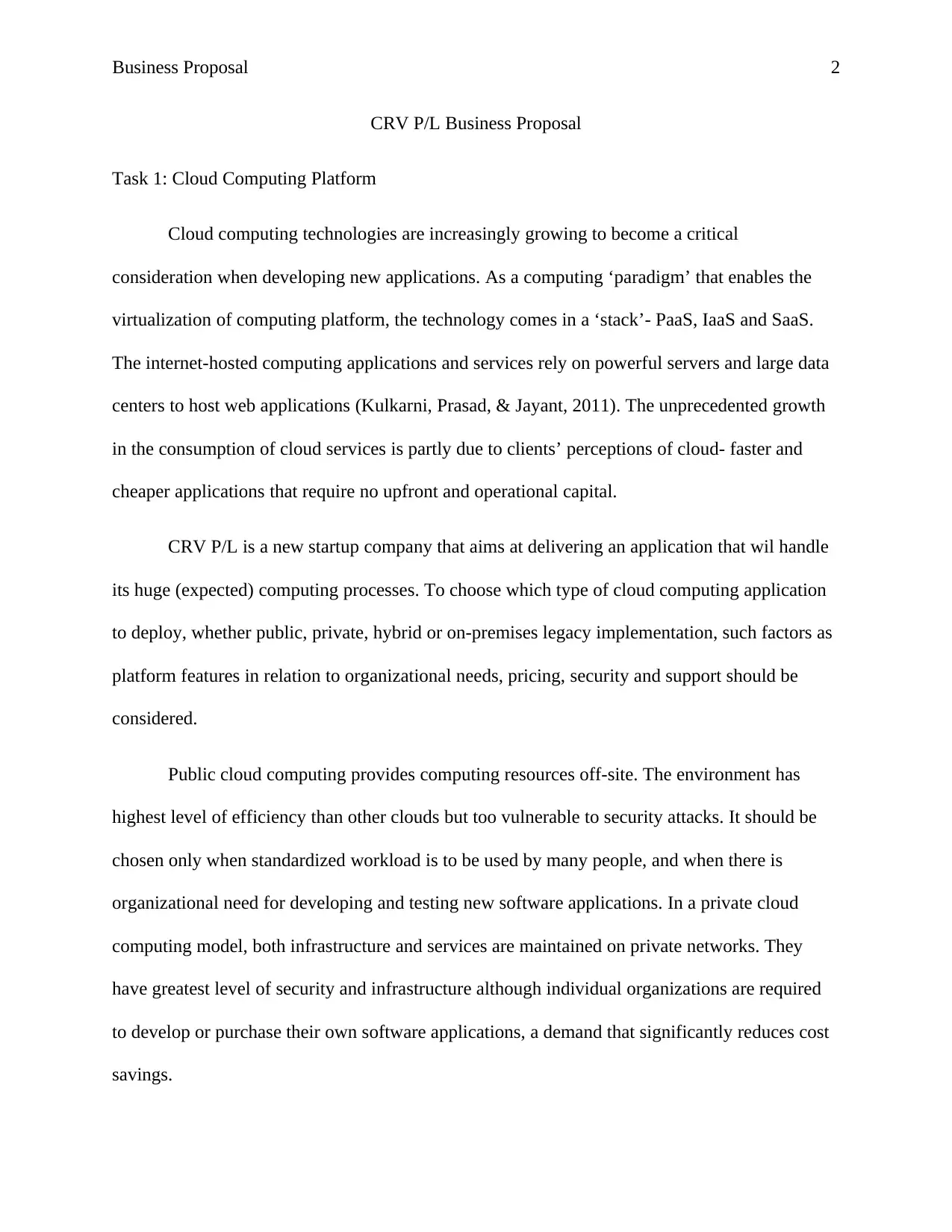
Business Proposal 2
CRV P/L Business Proposal
Task 1: Cloud Computing Platform
Cloud computing technologies are increasingly growing to become a critical
consideration when developing new applications. As a computing ‘paradigm’ that enables the
virtualization of computing platform, the technology comes in a ‘stack’- PaaS, IaaS and SaaS.
The internet-hosted computing applications and services rely on powerful servers and large data
centers to host web applications (Kulkarni, Prasad, & Jayant, 2011). The unprecedented growth
in the consumption of cloud services is partly due to clients’ perceptions of cloud- faster and
cheaper applications that require no upfront and operational capital.
CRV P/L is a new startup company that aims at delivering an application that wil handle
its huge (expected) computing processes. To choose which type of cloud computing application
to deploy, whether public, private, hybrid or on-premises legacy implementation, such factors as
platform features in relation to organizational needs, pricing, security and support should be
considered.
Public cloud computing provides computing resources off-site. The environment has
highest level of efficiency than other clouds but too vulnerable to security attacks. It should be
chosen only when standardized workload is to be used by many people, and when there is
organizational need for developing and testing new software applications. In a private cloud
computing model, both infrastructure and services are maintained on private networks. They
have greatest level of security and infrastructure although individual organizations are required
to develop or purchase their own software applications, a demand that significantly reduces cost
savings.
CRV P/L Business Proposal
Task 1: Cloud Computing Platform
Cloud computing technologies are increasingly growing to become a critical
consideration when developing new applications. As a computing ‘paradigm’ that enables the
virtualization of computing platform, the technology comes in a ‘stack’- PaaS, IaaS and SaaS.
The internet-hosted computing applications and services rely on powerful servers and large data
centers to host web applications (Kulkarni, Prasad, & Jayant, 2011). The unprecedented growth
in the consumption of cloud services is partly due to clients’ perceptions of cloud- faster and
cheaper applications that require no upfront and operational capital.
CRV P/L is a new startup company that aims at delivering an application that wil handle
its huge (expected) computing processes. To choose which type of cloud computing application
to deploy, whether public, private, hybrid or on-premises legacy implementation, such factors as
platform features in relation to organizational needs, pricing, security and support should be
considered.
Public cloud computing provides computing resources off-site. The environment has
highest level of efficiency than other clouds but too vulnerable to security attacks. It should be
chosen only when standardized workload is to be used by many people, and when there is
organizational need for developing and testing new software applications. In a private cloud
computing model, both infrastructure and services are maintained on private networks. They
have greatest level of security and infrastructure although individual organizations are required
to develop or purchase their own software applications, a demand that significantly reduces cost
savings.
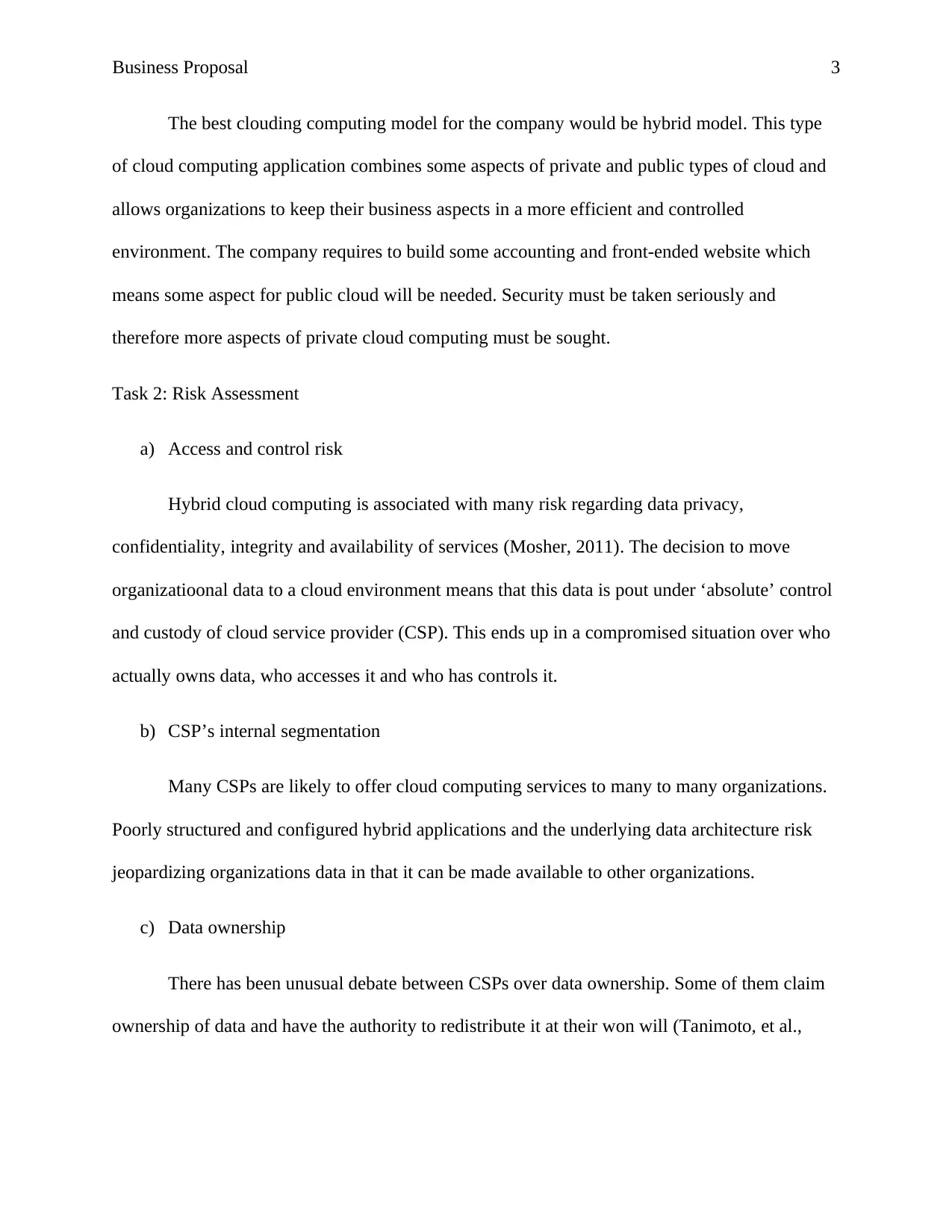
Business Proposal 3
The best clouding computing model for the company would be hybrid model. This type
of cloud computing application combines some aspects of private and public types of cloud and
allows organizations to keep their business aspects in a more efficient and controlled
environment. The company requires to build some accounting and front-ended website which
means some aspect for public cloud will be needed. Security must be taken seriously and
therefore more aspects of private cloud computing must be sought.
Task 2: Risk Assessment
a) Access and control risk
Hybrid cloud computing is associated with many risk regarding data privacy,
confidentiality, integrity and availability of services (Mosher, 2011). The decision to move
organizatioonal data to a cloud environment means that this data is pout under ‘absolute’ control
and custody of cloud service provider (CSP). This ends up in a compromised situation over who
actually owns data, who accesses it and who has controls it.
b) CSP’s internal segmentation
Many CSPs are likely to offer cloud computing services to many to many organizations.
Poorly structured and configured hybrid applications and the underlying data architecture risk
jeopardizing organizations data in that it can be made available to other organizations.
c) Data ownership
There has been unusual debate between CSPs over data ownership. Some of them claim
ownership of data and have the authority to redistribute it at their won will (Tanimoto, et al.,
The best clouding computing model for the company would be hybrid model. This type
of cloud computing application combines some aspects of private and public types of cloud and
allows organizations to keep their business aspects in a more efficient and controlled
environment. The company requires to build some accounting and front-ended website which
means some aspect for public cloud will be needed. Security must be taken seriously and
therefore more aspects of private cloud computing must be sought.
Task 2: Risk Assessment
a) Access and control risk
Hybrid cloud computing is associated with many risk regarding data privacy,
confidentiality, integrity and availability of services (Mosher, 2011). The decision to move
organizatioonal data to a cloud environment means that this data is pout under ‘absolute’ control
and custody of cloud service provider (CSP). This ends up in a compromised situation over who
actually owns data, who accesses it and who has controls it.
b) CSP’s internal segmentation
Many CSPs are likely to offer cloud computing services to many to many organizations.
Poorly structured and configured hybrid applications and the underlying data architecture risk
jeopardizing organizations data in that it can be made available to other organizations.
c) Data ownership
There has been unusual debate between CSPs over data ownership. Some of them claim
ownership of data and have the authority to redistribute it at their won will (Tanimoto, et al.,
⊘ This is a preview!⊘
Do you want full access?
Subscribe today to unlock all pages.

Trusted by 1+ million students worldwide
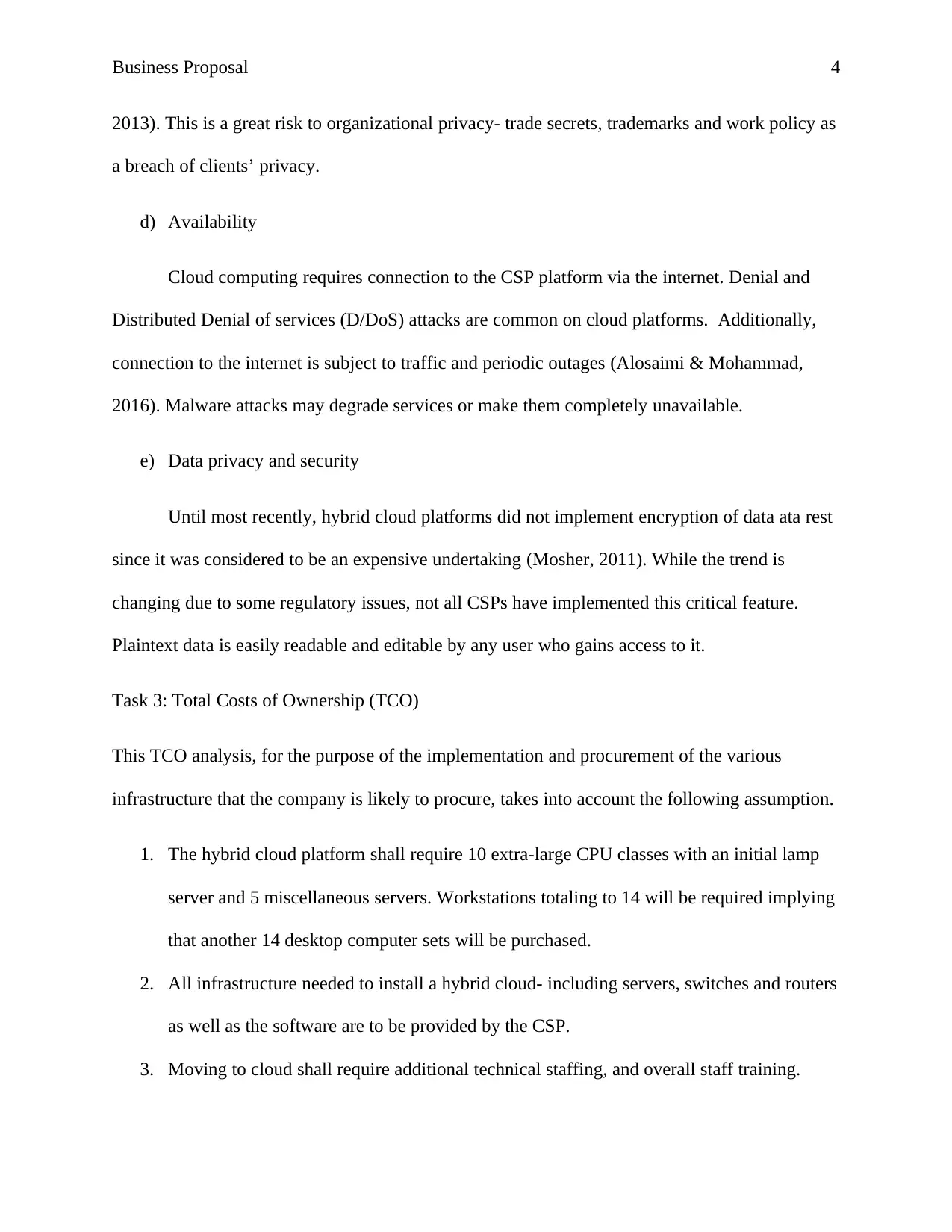
Business Proposal 4
2013). This is a great risk to organizational privacy- trade secrets, trademarks and work policy as
a breach of clients’ privacy.
d) Availability
Cloud computing requires connection to the CSP platform via the internet. Denial and
Distributed Denial of services (D/DoS) attacks are common on cloud platforms. Additionally,
connection to the internet is subject to traffic and periodic outages (Alosaimi & Mohammad,
2016). Malware attacks may degrade services or make them completely unavailable.
e) Data privacy and security
Until most recently, hybrid cloud platforms did not implement encryption of data ata rest
since it was considered to be an expensive undertaking (Mosher, 2011). While the trend is
changing due to some regulatory issues, not all CSPs have implemented this critical feature.
Plaintext data is easily readable and editable by any user who gains access to it.
Task 3: Total Costs of Ownership (TCO)
This TCO analysis, for the purpose of the implementation and procurement of the various
infrastructure that the company is likely to procure, takes into account the following assumption.
1. The hybrid cloud platform shall require 10 extra-large CPU classes with an initial lamp
server and 5 miscellaneous servers. Workstations totaling to 14 will be required implying
that another 14 desktop computer sets will be purchased.
2. All infrastructure needed to install a hybrid cloud- including servers, switches and routers
as well as the software are to be provided by the CSP.
3. Moving to cloud shall require additional technical staffing, and overall staff training.
2013). This is a great risk to organizational privacy- trade secrets, trademarks and work policy as
a breach of clients’ privacy.
d) Availability
Cloud computing requires connection to the CSP platform via the internet. Denial and
Distributed Denial of services (D/DoS) attacks are common on cloud platforms. Additionally,
connection to the internet is subject to traffic and periodic outages (Alosaimi & Mohammad,
2016). Malware attacks may degrade services or make them completely unavailable.
e) Data privacy and security
Until most recently, hybrid cloud platforms did not implement encryption of data ata rest
since it was considered to be an expensive undertaking (Mosher, 2011). While the trend is
changing due to some regulatory issues, not all CSPs have implemented this critical feature.
Plaintext data is easily readable and editable by any user who gains access to it.
Task 3: Total Costs of Ownership (TCO)
This TCO analysis, for the purpose of the implementation and procurement of the various
infrastructure that the company is likely to procure, takes into account the following assumption.
1. The hybrid cloud platform shall require 10 extra-large CPU classes with an initial lamp
server and 5 miscellaneous servers. Workstations totaling to 14 will be required implying
that another 14 desktop computer sets will be purchased.
2. All infrastructure needed to install a hybrid cloud- including servers, switches and routers
as well as the software are to be provided by the CSP.
3. Moving to cloud shall require additional technical staffing, and overall staff training.
Paraphrase This Document
Need a fresh take? Get an instant paraphrase of this document with our AI Paraphraser
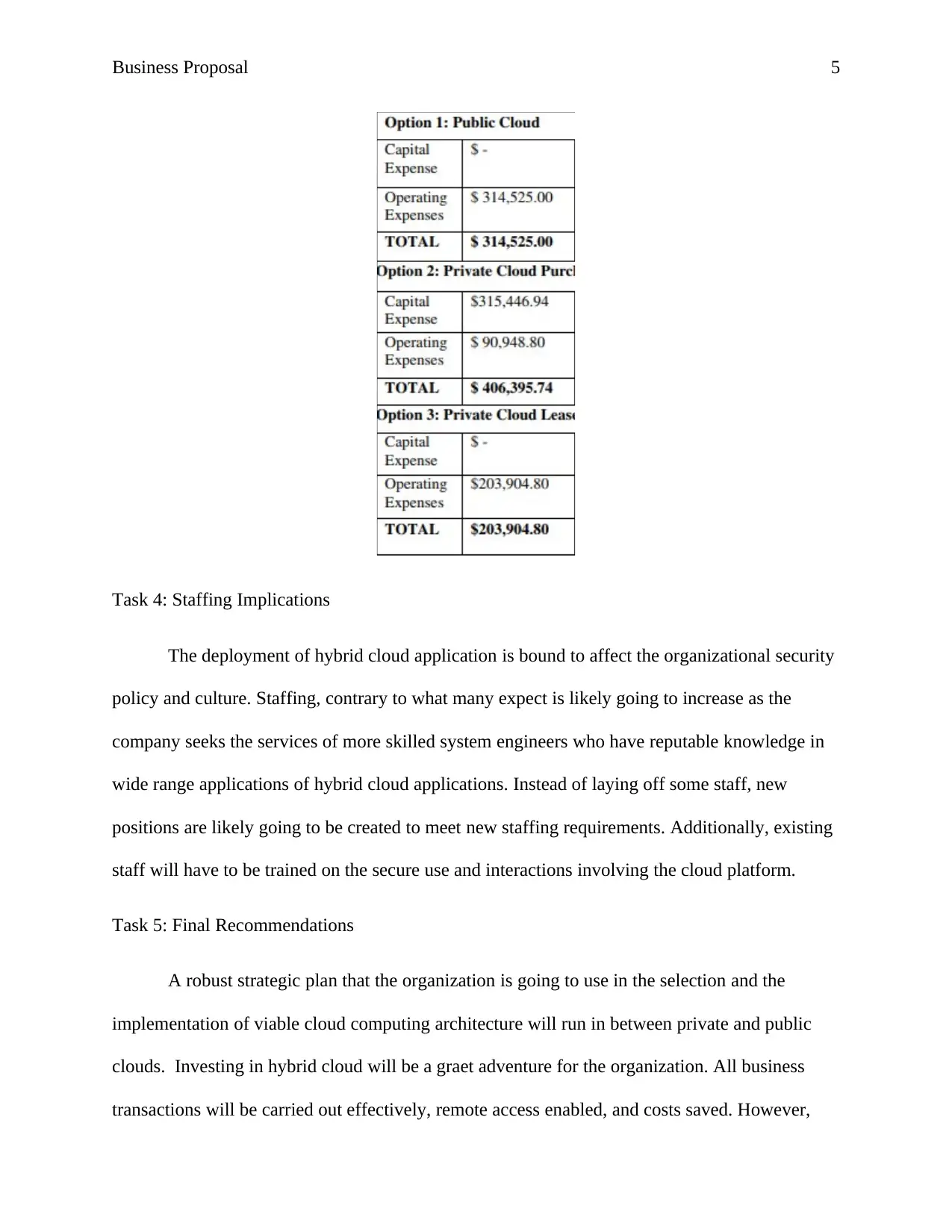
Business Proposal 5
Task 4: Staffing Implications
The deployment of hybrid cloud application is bound to affect the organizational security
policy and culture. Staffing, contrary to what many expect is likely going to increase as the
company seeks the services of more skilled system engineers who have reputable knowledge in
wide range applications of hybrid cloud applications. Instead of laying off some staff, new
positions are likely going to be created to meet new staffing requirements. Additionally, existing
staff will have to be trained on the secure use and interactions involving the cloud platform.
Task 5: Final Recommendations
A robust strategic plan that the organization is going to use in the selection and the
implementation of viable cloud computing architecture will run in between private and public
clouds. Investing in hybrid cloud will be a graet adventure for the organization. All business
transactions will be carried out effectively, remote access enabled, and costs saved. However,
Task 4: Staffing Implications
The deployment of hybrid cloud application is bound to affect the organizational security
policy and culture. Staffing, contrary to what many expect is likely going to increase as the
company seeks the services of more skilled system engineers who have reputable knowledge in
wide range applications of hybrid cloud applications. Instead of laying off some staff, new
positions are likely going to be created to meet new staffing requirements. Additionally, existing
staff will have to be trained on the secure use and interactions involving the cloud platform.
Task 5: Final Recommendations
A robust strategic plan that the organization is going to use in the selection and the
implementation of viable cloud computing architecture will run in between private and public
clouds. Investing in hybrid cloud will be a graet adventure for the organization. All business
transactions will be carried out effectively, remote access enabled, and costs saved. However,

Business Proposal 6
security, data privacy and control will force the organization to adjust its staffing. Security
challenges associated with hybrid cloud requires a vivid solution and focus.
security, data privacy and control will force the organization to adjust its staffing. Security
challenges associated with hybrid cloud requires a vivid solution and focus.
⊘ This is a preview!⊘
Do you want full access?
Subscribe today to unlock all pages.

Trusted by 1+ million students worldwide
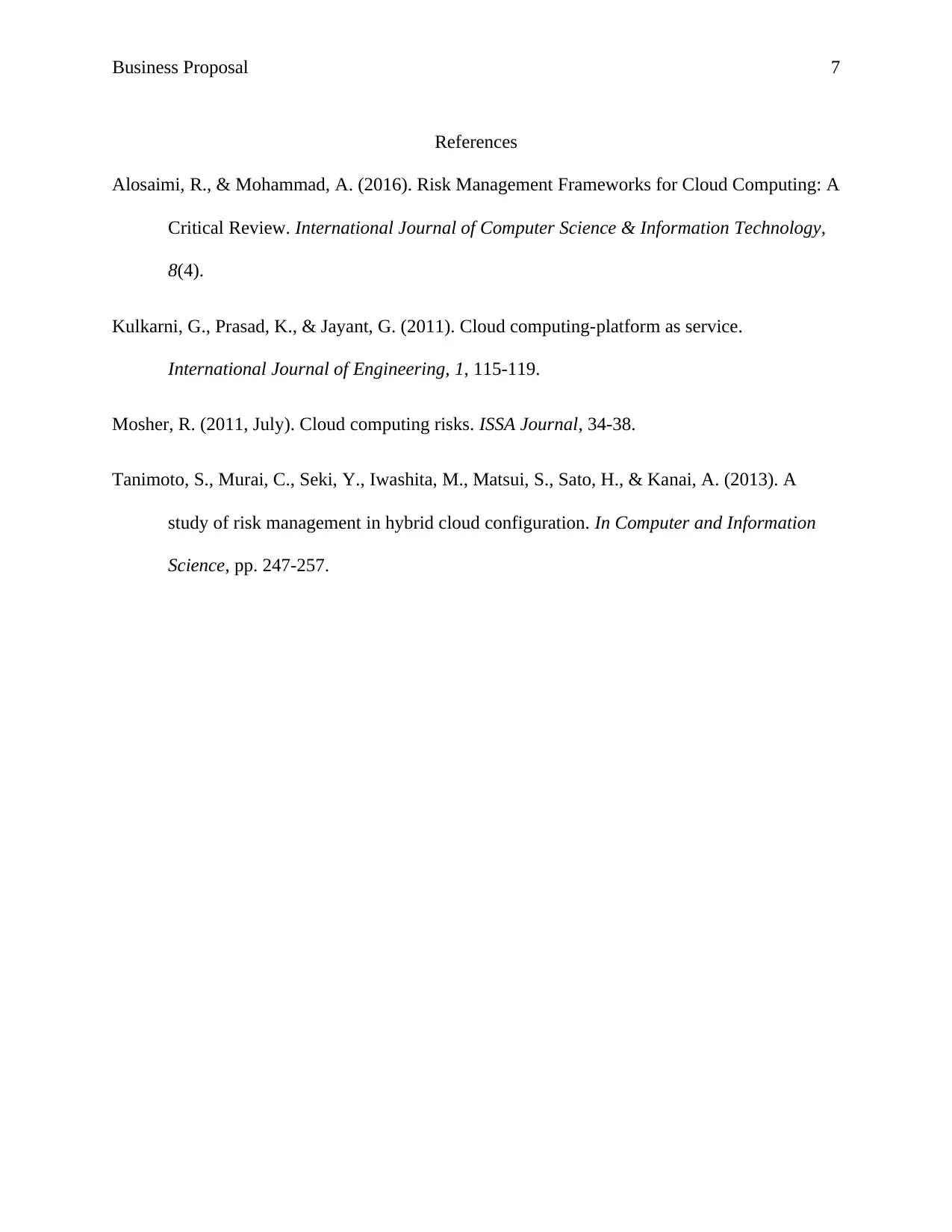
Business Proposal 7
References
Alosaimi, R., & Mohammad, A. (2016). Risk Management Frameworks for Cloud Computing: A
Critical Review. International Journal of Computer Science & Information Technology,
8(4).
Kulkarni, G., Prasad, K., & Jayant, G. (2011). Cloud computing-platform as service.
International Journal of Engineering, 1, 115-119.
Mosher, R. (2011, July). Cloud computing risks. ISSA Journal, 34-38.
Tanimoto, S., Murai, C., Seki, Y., Iwashita, M., Matsui, S., Sato, H., & Kanai, A. (2013). A
study of risk management in hybrid cloud configuration. In Computer and Information
Science, pp. 247-257.
References
Alosaimi, R., & Mohammad, A. (2016). Risk Management Frameworks for Cloud Computing: A
Critical Review. International Journal of Computer Science & Information Technology,
8(4).
Kulkarni, G., Prasad, K., & Jayant, G. (2011). Cloud computing-platform as service.
International Journal of Engineering, 1, 115-119.
Mosher, R. (2011, July). Cloud computing risks. ISSA Journal, 34-38.
Tanimoto, S., Murai, C., Seki, Y., Iwashita, M., Matsui, S., Sato, H., & Kanai, A. (2013). A
study of risk management in hybrid cloud configuration. In Computer and Information
Science, pp. 247-257.
1 out of 7
Related Documents
Your All-in-One AI-Powered Toolkit for Academic Success.
+13062052269
info@desklib.com
Available 24*7 on WhatsApp / Email
![[object Object]](/_next/static/media/star-bottom.7253800d.svg)
Unlock your academic potential
Copyright © 2020–2025 A2Z Services. All Rights Reserved. Developed and managed by ZUCOL.



